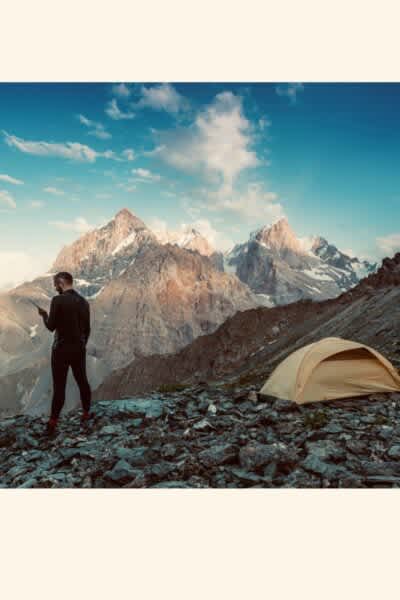Taylor Hutchinson 03.15.24

Off-grid communication networks offer a backup solution for staying connected when the phone lines go down and disaster strikes. These off-grid solutions offer a decentralized infrastructure that has built-in reliance to add communication continuity to your emergency preparedness. Covered in Part 1 of this article are various radio services and options for voice, messaging, and GPS data. While radios can cover a wide range of needs. Having options available to build a layered communication plan is important. Not everyone needing to be contacted may have or want to learn to use a radio. A lower barrier to entry option that provides encryption for privacy and security may be warranted. Adding more options in the methods used to communicate allows for flexibility and continued service continuity. This is where mesh networks and satellite systems come in place.
Mesh Networking
As covered in Part 1, radios can incorporate encryption. The higher barrier to entry and regulation on what services allow for encryption can deter most individuals. Mesh systems can fulfill this requirement and many more when set up properly. A mesh network is a topology in which each node relays data for the network. All participating nodes cooperate in the distribution of data across the network. Mesh networks benefit from their lack of centralization and their ability to dynamically self-organize and self-configure, which can help the network efficiently route data from and to each node. In the framework of emergency communication, devices that utilize LoRa, a long-range wireless protocol, fit nicely into their niche operation. It operates in the unlicensed bands, which vary regionally (such as 868 MHz in Europe, 915 MHz in North America, and 433 MHz in Asia), and is based on spread spectrum modulation techniques derived from chirp spread spectrum (CSS) technology. LoRa’s most notable feature is its long-range capability, which can exceed 6 miles in rural areas with line-of-sight conditions, and 1 to 3 miles in urban areas. The range is further extended by creating a mesh network of nodes to act as repeaters for transmissions. LoRaWAN includes end-to-end encryption without the need for regulatory compliance. Various projects exist that support LoRa and mesh networks. One of these is Meshtastic. A project that is community-driven and open source that opens a new world up to the DIY individual. These devices are focused on off-grid text messaging and geolocation. Networks can operate with or without a smartphone, and, unlike amateur radio, do not require additional licensing or certifications. Nodes have low power consumption, and many have the option to run off solar panels for setting up perpetual repeater deployments. Many devices offered that run Meshtastic are DIY boards that can be set up at home and customized to fit various needs. Require a node for backpacking and staying connected to a small group of friends? How about a node for tracking hunting dogs while deep in the woods trailing game? Setting up a base camp far from cell towers and data lines? There are devices for that and more. The community built around Meshtastic offers devices, custom cases, and frameworks that are well outside the scope of this article. However, the barrier to entry is low and one can get started for less than $50. Out-of-the-box solutions do exist for businesses and individuals, such as GoTenna and Beartooth. That being said, best to wade in the shallow end before nose-diving head first. Understanding LoRa and mesh systems will present a new world of possibilities for one’s emergency planning.

Satellite
The last off-grid communication option being discussed today may be obvious to some. However, integrating this into a holistic plan is what is important. Remembering, the whole point of off-grid communications is to stay in touch with the outside world without having to rely on the “one way” to do things. Satellite communications involve the use of orbiting satellites to relay communication signals between various points on the ground, enabling long-distance communication even in remote or hard-to-reach areas. Transmissions start with ground stations sending a signal to satellites in orbit via a transmitter. This signal can contain various types of data, including voice, video, or other digital data. The satellites receive the signal with its onboard transponder, amplify it, and change the frequency to avoid interference with the uplink signals. It then retransmits the signals back down to Earth to another ground station on Earth. This station could be a fixed satellite dish, a portable receiver, or even a mobile device equipped to receive satellite signals. Apple’s iPhones recently started supporting satellite communication for emergencies only. Starlink stations are helping support war efforts in Ukraine. Other hardware options exist for the American consumer, such as Garmin’s inReach devices paired with the Iridium satellite network. They provide standalone handhelds, tablets, and even watches that can interact with a smartphone to transmit messages and data. While this does require a subscription fee, most satellite-based services in the US will as well. Layering these systems is what is key here.

Reviewing all of these solutions can seem overwhelming at times. Knowing one’s specific needs, requirements, and budget will help narrow the pool of options that make sense for an individual or community. Keeping in mind the sustainability of each system is important when dealing with emergency preparedness. Buying high-end gear may come with high-end, time-consuming maintenance. It’s best to evaluate one’s needs and knowledge before taking on a heavy investment in hardware. There are a plethora of free resources available and entry-level hardware to get one started. Not everything we own has to align with the top-tier professionals, we just need to make sure our family has food and water when a hurricane hits. Community engagement and planning reap higher benefits than any gear purchase. Just be sure to stay connected, regardless of what disasters lay ahead.

